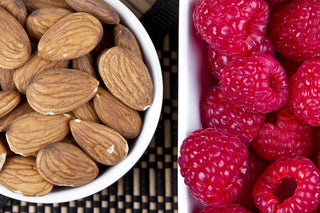Are you tired of counting calories or measuring food in your quest to lose weight? Do you feel confused about what foods to avoid and which macronutrients to eat? Do you find that eating healthy is difficult?
You're not alone.
Whether you’re trying to lose weight or eat healthier this summer, you can reach your goal by following this one simple guideline:
Eat more fiber.
Fiber and Weight Loss
In a recent study, participants who were advised to eat 30 grams of fiber a day lost almost as much weight over the course of a year as participants told to follow the American Heart Association’s dietary recommendations.
“A permissive dietary plan may produce more beneficial effects than a restrictive plan.”
The AHA recommends sensible guidelines like eating a variety of fruits and vegetables, choosing poultry and fish without skin and limiting consumption of saturated fat, trans-fat and sodium. In this study, participants following the AHA guidelines were able to lose an average of 6 pounds.
For some dieters, following these guidelines may seem overwhelming. So, instead of focusing on what dieters should limit in their diet, researchers told half of the participants to focus on a single addition to their diet: consuming 30 grams of fiber per day. Using this simplified approach to weight loss, the high-fiber followers lost an average of 4.6 pounds during the year-long study.
Fiber's Healthy Halo
How does making one dietary change (getting 30 grams of fiber daily), lead to more "effortless" weight loss?
One reason is that by increasing your intake of high-fiber foods, you “crowd out” unhealthier options. In doing so, you’re naturally making healthier dietary choices without realizing it. By displacing cookies, crackers and chips with high-fiber fruits, vegetables and nuts, your total intake of calories, fat and added sugars are automatically reduced. This leads to weight loss.
Another reason is that high-fiber foods help to reduce hunger because they require extra chewing. You can quickly scarf down a bag of chips but it takes longer to munch through a handful of carrots. By staying in the stomach longer to digest, high-fiber foods create a sense of fullness. These foods also help to tamp down hunger hormones. Because these foods are broken down slowly, it helps to maintain blood sugar levels and improves insulin sensitivity.
Goal: Double Your Fiber Intake
How much fiber do you get in an average day? Most likely you’re only getting 15 grams which is way below the 25 to 38 grams that is recommended.
That means you need to up your fiber game by 15 grams a day.
What’s the best way to boost your fiber intake? By eating a wide variety of fruits, vegetables, nuts & seeds and whole grains. Add an extra fiber serving at each meal, and you’ll easily double your fiber intake.
Here’s a good rule of thumb for the fiber content of five healthy food groups:
- Beans and legumes: 10-12 grams per cup
- Vegetables: 5-9 grams per cup
- Fruits: 4-6 grams per serving
- Whole grains: 4-6 grams per serving
- Nuts and Seeds: 2-5 grams per serving
Perhaps more importantly, you will promote a balanced, healthy gut. By increasing fiber intake you’ll promote Bacteriodetes, a type of bacteria associated with thin individuals.

